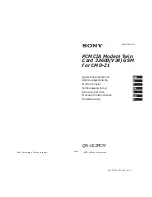
X7200/X7200HP RADIO MODEM
1.0 FEATURES
• Type approved for licence free use.
• 17 selectable radio channels.
• Range 10Km to 20Km line of sight and 1Km to 3Km in buildings
• Serial Interface with baud rates of 1200 to 19200.
• RS232 flow control for duplex operation
• Two data transmission speeds.
• 4K of buffer memory.
• Two data repeater modes to extend range.
• Addressable individually and globally
• On-line AT commands for modem dial-up operation and RF channel change.
• Predictor/Corrector error checking mode
• Transmitter keying for site surveys and antenna alignment.
• Low power mode
The X7200 Radio Modem transmits and receives half duplex serial data at baud rates of
1200 to 19200 by means of a FM Radio Transceiver operating on the UK licence except
458.500MHZ to 458.950MHZ band and most other world wide data frequencies - The radio
conforms to MPT1329 and the European ETSI 300-220 standards.
A 4K buffer memory is provided so that data can be passed asynchronously between the
host and modem without the need for handshaking. The CTS output signal can be used for
flow control in duplex applications. It indicates to the host that the RF channel is in use or that
the buffer memory is full. The X7203 interface unit is available if large computer files need to
be transferred with full duplex operation. This add-on unit will provide data packeting, data
encryption and data packet retries.
The over air data speed can be configured at either 5K bits/sec or
10K bits/sec. This is independent of the baud rate and should be set to a lower value were
possible for the best results.
All the parameters on the X7200 radio modem can be set by an internal menu selected by
connecting pin 6 on the 9 way
D Connector to 0v or typing $ ESC directly after the power has
been applied. The menu configuration is permanently stored on EEPROM.
A modem can be used in an open configuration in the same way as a RS485 bus or given a
unique transmitter and receiver address. If the address mode is selected only modems with
the same address can communicate with each other. In addition “AT” commands can be
sent to the modem to change the address configuration during normal operation so that any
modem can “dial up” any other modem. These commands are used in specific ways and do
not restrict the use of any data strings or combinations of data.
A forward error correcting algorithm can be configured to increase the integrity of the data
transmission at high speed or over long distances.
The modem can be configured in two repeater modes. The first mode will command any
modem in range to repeat back the data it has just received thereby testing data integrity and
radio range. The second repeater mode uses the address mode to form repeater chains
thereby extending the range of a transmission over physical obstacles or in shaded areas.
The RF frequency is set by the menu, or DIL switches located inside the modem, or by an



































